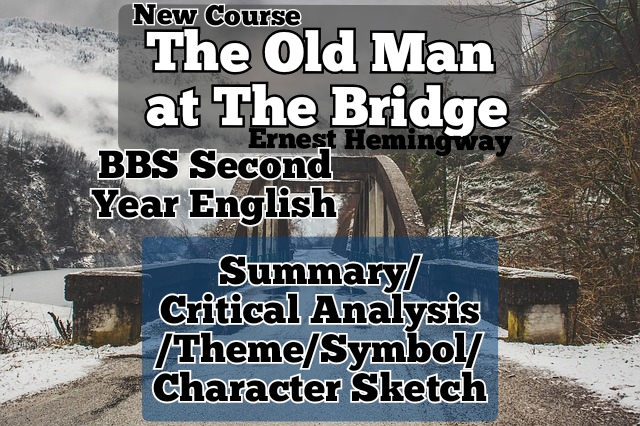Old Man at the Bridge by Ernest Hemingway
Summary/Critical Analysis/Theme/Character Analysis
Summary/Critical Analysis of the Story Old Man at the Bridge by Ernest Hemingway
It is a story written by the Nobel Prize winner American writer Ernest Hemingway. The story presents a conversation between two characters. The story is presented through the first person narrative of a soldier. We only know his gentle behaviour. We don’t know his full background. They are a soldier and an old man. The narrator is a soldier.
We find the use of ordinary details in an interesting way to capture the crisis caused by war. The old man symbolizes a civilian who is the victim of war. The old man is forced to leave his home when Spanish Civil War starts. The war brings destruction, suffering, anxiety and pain in the civilians. The old man seems exhausted because of the war.
He was 76 years old. He had travelled 12 kilometers journey to reach there. He is sitting by the side of a bridge(pontoon). He is by the side of a road. The soldier starts talking with him. The old man had left his home. He didn’t have a family.He used to live alone. He was thinking about his animals. He was more worried about his animals especially about goats and pigeons. He had two goats, a cat and eight pigeons.
He left his town after a captain told him to flee from there. He ran from there after artillery fire. The old man wasn’t worried about his life. He was concerned about the safety of his animals. He wanted to to reach Barcelona. The soldier was worried about the old man’s safety. The old man was happy for the soldiers’ concern about him.
At the end of the story, the soldiers failed to solve the concern about the safety of the animals. He couldn’t do anything to save them. In this way, the story captures the dark sides of a civil war. It tries to capture different facets of the civil war of spain. It brings the theme of depression, suffering, miseries and pain caused by the war. It becomes able to capture physical as well as
Old Man at the Bridge Theme
The story ‘Old Man at the Bridge’ presents the themes of depression, suffering, pain and isolation caused by the war. It also highlights the theme of forthcoming death. We come to know the theme through the conversation between two characters.
The old man is homeless. He was forced to leave his homeland due to the Spanish Civil War. He was one of the victim of the war. He was suffering from pain and anxiety after leaving his beloved animals. He was 76 years old but he had travelled 12 km long journey to follow his destination. He was tired to continue his journey to reach a proper safe place.
If Fascists reach to the bridge then he may lose his life. The old man death is following him. The narrator advised him to leave the place. But he was more concerned about his animals than his own life.
Character Analysis in the story Old Man at the Bridge
THE OLD MAN
- Central character/hero of this story.
- He was 76 years old.
- He was healthy and physically fit.
- He was the victim of the civil war.
- He was forced to leave his hometown.
- He had no family.
- He was more concerned about his animals safety than his life.
- He believed in his fate.
Analyze the use of Symbols in the story Old Man at the Bridge
- Bridge : Symbol of uncertainty and upcoming dangers.
- Pigeons: Symbol of peace and harmony.
- Cat : Symbol of survival.
- Goat: Symbol of innocent civilians. They are major victims of the war.

